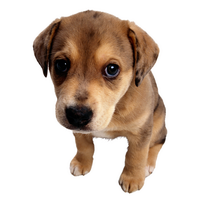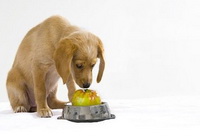Choosing a healthy puppy
 Healthy puppies are active, energetic, playful and cheerful. At first glance, they are all fluffy “buns” that you want to caress. The size and weight of puppies depend on the number of babies in the litter, but to a greater extent on the correct care and feeding. Keep in mind that a healthy puppy of a large breed at the age of 30 days should weigh at least 2.5 kg, and at two months of age – at least 6 kg. It should not be fat or thin, rather – downed and strong.In all cases, the features of the exterior and temperament must match the breed type.
Healthy puppies are active, energetic, playful and cheerful. At first glance, they are all fluffy “buns” that you want to caress. The size and weight of puppies depend on the number of babies in the litter, but to a greater extent on the correct care and feeding. Keep in mind that a healthy puppy of a large breed at the age of 30 days should weigh at least 2.5 kg, and at two months of age – at least 6 kg. It should not be fat or thin, rather – downed and strong.In all cases, the features of the exterior and temperament must match the breed type.
Distinguishing a seriously ill puppy is quite simple: boring, watery eyes, dry nose, ruffled fur, sunken or, conversely, swollen tummy, weakness of the limbs. The unfortunate baby is lying all the time, trying to get into a secluded dark place, whining or moaning. He may have vomiting and diarrhea, staggering or stooping gait. Ask the breeder to feed the babies in your presence – the sick puppy will refuse to eat. Naturally, to take such a puppy is not recommended.
However, cute kids can have hidden ailments, the symptoms of which are not evident. That is why take your time with the final choice. First examine the puppy’s head. The nose should be cool and wet when in rest, however, in a sleeping dog it may be dry, and during physical exertion and high air temperatures it may be warm. Squeezing the nostrils for a few seconds, you will find out if the puppy has mucous discharge. Their presence and frequent sneezing may indicate inflammation or allergies of the respiratory tract. Puppy nostrils should be wide open while inhaling. However, in short-breeds (boxers, pugs, bulldogs) the nostrils are often compressed, with compression (sticking) occurring during inhalation.
Carefully inspect the puppy’s teeth. For most breeds, the standard requires a scissor bite, when the upper incisors closely overlap the lower ones. If a match head passes between the upper and lower incisors, then there is an overshot point that is unlikely to correct with age. A more pronounced underdevelopment and shortening of the lower jaw in veterinary practice is called the mouth of a parrot. When snacking, the lower incisors are in front of the upper ones. Such a structure is the norm for bullmastiffs, bulldogs, pugs, Bordeaux dogs, boxers and other dogs with a brachycephalic skull; however, for other breeds – disqualifying defect. Count the number of front teeth (incisors) – there should be six on the upper and six on the lower jaw. It is desirable that the incisors are located in one line. The gums should be pink and strong. Pale gums indicate anemia, most often caused by massive intestinal invasion of round parasitic worms. When viewed from the pharynx enlarged tonsils in combination with cough indicate tonsillitis (angina).
Choosing a healthy puppy: Feel the top of the puppy’s head to eliminate a non-growing spring – a soft area in the parieto-occipital region. Eyes should look strictly forward, without deviation in one direction or another. Tearing reddened eyes and brown drips on the face are eloquent signs of conjunctivitis, which may indicate a variety of pathologies in the body. The eyelids should tightly cover the eyeball, however, in some sandy rocks with a loose constitution of composition (Neapolitan mastiffs, basset hounds, bloodhounds), the standard suggests pendulous, turned eyelids. In small puppies, the cornea is bluish, but becomes brown with age. Dark brown eyes in adult dogs of most breeds indicate a good overall pigmentation and are welcomed by the standard. Pupils should be black, with no visible furrows or white inclusions. The third eyelid in the inner corner of the eye may be clearly visible, which is not a sign of the disease, if it is not enlarged or inflamed.
Ears should be aligned with breed characteristics. German and Belgian Shepherd dogs have small puppies that have hanging ears that rise with age due to the strengthening of cartilage. Be sure to check the condition of the auricles and external auditory passages – they must also be clean, without redness, wounds and accumulations of sulfur. Shaking the head, the forced position of the bowed head and the obvious pain in the ear indicate inflammation of the ear canal – otitis. The tips of the ears should be healthy and evenly covered with hair. The presence of bald patches, crusts and wounds in this place speaks of itchy scabies. Check the hearing acuity of the selected puppy, because some white dogs (Dalmatians, bull terriers, etc.) carry the gene of congenital deafness.
Gently squeeze the trachea on the front of the puppy’s neck. An attack of cough indicates inflammation of the trachea or bronchi. Putting the palm on the left side of the chest, you can feel the heart beat and vibration, which can be used to judge the presence of heart disease. However, in small thin puppies with a thin-walled rib cage, there is often a visible tremor of the ribs during a heart jerk.



